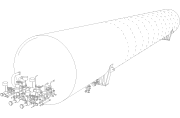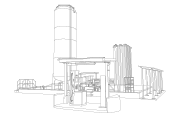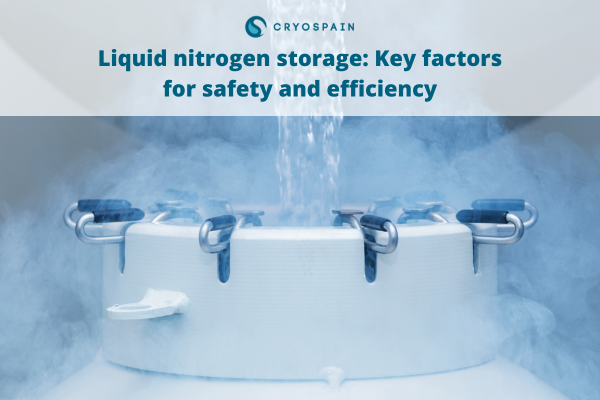The safe storage of liquid nitrogen plays a key role in the availability of this substance. Present in a wide range of industries, liquid nitrogen is now an essential component for many products that are already part of everyday life.
Liquid nitrogen is essentially nitrogen that has been cooled to transition from a gaseous to a liquid state. In this state, it exhibits unique properties that give rise to its uses across various sectors, ranging from the food industry to medicine.
However, to access these properties, precise liquid nitrogen storage is required to prevent the potential risks specific to this substance, while also achieving maximum efficiency and avoiding resource wastage.
In this article, we share more about LN₂ and the key factors for designing a safe liquid nitrogen storage system.
What is liquid nitrogen?
At room temperature, nitrogen is a colorless and odorless gas that makes up approximately 78% of the Earth’s atmosphere. When subjected to temperatures below -195.8°C, liquid nitrogen forms, and its production involves designing a liquefaction process that includes compression and cooling techniques.
If exposed to room temperature again, liquid nitrogen quickly evaporates. This particularity regarding the temperature of liquid nitrogen is behind some of the key considerations when designing cryogenic liquid nitrogen storage systems.
It is also important to understand that nitrogen has a much higher density in its liquid form (compared to its gaseous state). This allows large quantities of this substance to be stored in a relatively small volume.
You may also be interested in: Cryogenic liquid nitrogen: applications and advantages in industries
Main uses of liquid nitrogen
The extremely low temperature of liquid nitrogen allows this substance to be used to freeze a wide variety of materials through direct contact.
This property is behind the variety of uses of LN₂ as a resource, including:
- Among its industrial applications is the treatment of metals and other materials to improve their strength.
- In the food industry, it is used to create ultrafreezing processes, which extend the shelf life of food while preserving its quality. This is because it results in an extremely rapid freezing process, generating smaller crystals compared to slower freezing methods.
- In medicine, it is used to freeze and preserve biological samples. It is also essential in the development of cryotherapies, which are based on treating certain diseases through the freezing of tissues.
- It is a fundamental resource in laboratories and research centers, as it allows for the creation of low-temperature conditions essential for certain experiments.
- As part of the technology sector, it is useful for the manufacturing of components such as microprocessors or LEDs, among others.
Importance of proper liquid nitrogen storage
Harnessing all the benefits and opportunities that LN₂ offers requires the design of a safe and efficient liquid nitrogen storage system.
Liquid nitrogen presents specific risks that must be addressed both in its storage and during its handling, including:
- Burns: direct contact with liquid nitrogen can cause frostbite on the skin and internal tissues. These injuries can be severe, similar to cold burns, and may even lead to tissue loss.
- Asphyxiation risk: Liquid nitrogen can displace oxygen in the atmosphere, creating a risk of asphyxiation in the event of a leak in an enclosed space.
- Explosion: If a leak occurs and liquid nitrogen comes into contact with room temperature, it expands about 700 times its original volume. In enclosed, unventilated areas, this scenario can pose a risk of explosion.
- Fire: In the event of a leak, liquid nitrogen can cool the surrounding air, potentially condensing oxygen and thereby increasing the risk of fires or explosions.
Related reading: Cryogenic liquid gases: differences and common uses of LNG, LIN, LOX, LAR and LC02
For these reasons, liquid nitrogen storage must take into account the following basic principles:
- It must be designed to maintain the extremely low temperatures required for LN₂ to retain its liquid form.
- It must be equipped with valves to prevent the risk of excessive pressure.
These systems, in turn, must be accompanied by a series of safety and maintenance procedures, as explained below.
Where should liquid nitrogen be stored?
Maintaining the temperature of liquid nitrogen is one of the key considerations when choosing a storage system. Only by keeping the temperature at the proper level at all times can the quality of the nitrogen be guaranteed, along with its safe and efficient use.
Therefore, the cryogenic tank must be capable of minimizing potential heat transfer with the surroundings, which would result in thermal energy loss and the additional economic costs that this implies.
Within the storage options capable of fulfilling this task, there are two main categories of systems:
Liquid nitrogen dewar
A liquid nitrogen Dewar is a type of storage system designed to maintain extremely low temperatures.
First developed in the 19th century, it has evolved to become a key component of modern cryogenic storage systems. Its basic premise is as follows: the container has double walls with a vacuum between them, which acts as an insulator and reduces heat transfer, minimizing the evaporation of liquid nitrogen. This system can be further enhanced by adding reflective materials and is available in various sizes.
The dewar is considered one of the most versatile options for liquid nitrogen storage, as it is available in various sizes, ranging from small-scale Dewars to containers with larger volumes.
Cryogenic tanks and their technology
Cryogenic tanks are another option for liquid nitrogen storage. In this case, these systems are designed to hold large volumes of the substance, making them useful for applications that require a large and continuous supply of LN₂.

Its basic structure is divided into the following parts:
- Inner stainless steel container, capable of withstanding the cryogenic temperatures required for liquid nitrogen.
- Outer carbon steel container.
- Insulating materials that separate the two containers.
- Pressure regulation system, which ensures a constant pressure within the tank.
Safety measures in liquid nitrogen storage
Ventilation and pressure control systems
In order to avoid the risks outlined above, any protocol aimed at optimizing the safety of liquid nitrogen storage should integrate:
- Ventilation systems. They are responsible for preventing nitrogen from displacing oxygen and creating an asphyxiation hazard in the event of leaks.
- Relief valves and rupture or burst disks. In the event of gas buildup inside the container, these systems automatically regulate the gas, preventing a pressure increase that could ultimately lead to an explosion.
Handling protocols to prevent accidents
Some of the most notable include::
- Storage should take place in well-ventilated areas.
- Risks should be indicated with appropriate signage: warning of cold burns and asphyxiation hazards.
- Personnel must wear personal protective equipment (PPE), including cold-resistant gloves up to the forearm, facial and eye protection. Clothing should also have specific considerations, such as avoiding open pockets or cuffs, and covering the entire body.
- Handling should always be carried out by trained personnel to ensure the process is performed safely.
- In the event of spills, it is essential to evacuate the area and notify the relevant emergency services.
- The transportation of liquid nitrogen must also occur in specific systems, with double walls and vacuum insulation.
Optimization of storage: how to minimize losses and improve efficiency
Reduction of evaporation losses
As described above, the design of an adequate insulation mechanism is at the core of a storage system capable of reducing evaporation losses.
Selecting appropriate cryogenic containers is key here, but it is also important to follow best practices in sealing the container after use and choosing the proper storage area.
The installation of monitoring equipment is also recommended, as it can track potential temperature and pressure variations in real time, triggering alarms that allow for timely corrective action.

Technological innovations in cryogenic storage
- The integration of storage systems into IoT (Internet of Things) ecosystems opens the door to real-time visibility of temperature, pressure, and liquid level parameters. In this way, alerts are generated automatically and instantly, allowing for timely corrections.
- The implementation of automatic mechanisms (e.g., for opening covers) allows for more precise handling and helps prevent potential human errors.
- Advancements in systems and materials open the door to improving insulation and protection capabilities.
Cryospain: Cryogenic storage solutions
At Cryospain, we apply our expertise in advanced cryogenic engineering to develop tailor-made solutions for liquid nitrogen storage. We specialize in the design, manufacturing, assembly, and commissioning of flat-bottom cryogenic nitrogen tanks.
With over two decades of experience, our solutions use the highest quality insulation materials and are designed to meet the applicable quality and safety certifications.
Some of our projects for liquid nitrogen storage include:
- A cryogenic tank in Chandler (USA) intended for microchip manufacturing.
- Our cryogenic storage solution in Taichung (Taiwan) for the same use in an area of high seismic activity and exposed to strong winds and typhoons.
- The cryogenic tank project in Abu Dhabi (United Arab Emirates), characterized by a desert climate, extreme temperatures, and exposure to radiation.
A series of success stories that illustrate our work in adapting to the needs of each project, including the strictest technical requirements, to provide turnkey liquid nitrogen storage solutions. Get in touch with us and speak with our team about how we can assist you!










 Contacte-nos
Contacte-nos